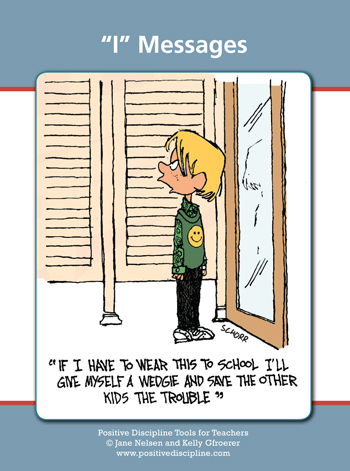Excerpt from Positive Discipline Tools for Teachers
by Dr. Jane Nelsen and Dr. Kelly Gfroerer

Ask your students to make a list of things other people do that invite them to feel annoyed or angry (that is, what bugs them). The list might include things such as cut- ting in line, gossip, and not being invited to join a game. Let them know it is okay to exaggerate when they are brainstorming to make it more fun.
Then share an example of how to use the “I feel __________ about __________, and I wish __________” formula: “I feel hurt when you don’t let me join the game, and I wish you would let me take a turn in the game.” It can be helpful to role-play certain situations, such as bullying, pushing at the water fountain, or not helping to return the play equipment, to give students the opportunity to practice using “I” messages. Let them practice until they feel comfortable sharing their feelings and wishes.
Self-regulation (taking responsibility for one’s feelings) is an important social and life skill. “I” messages require self-regulation, and students seem to enjoy learning this language and practicing it.
Tool in Action from London, England
About a week after teaching my tenth-grade students how to use “I” messages (I always joke with them that I don’t mean messages on the iPhone), I had a student ask if he could come and speak to me about his essay grade. He came to me and said, “Ms. Marchese, I feel confused about my essay grade because I worked really hard on the assignment and I don’t understand why I received such a low grade.”
This was brilliant! If he had approached me with his usual tone, he might have said, “Ms. Marchese, I don’t think the grade you gave me is fair!” With this approach, I would have felt inclined to defend the grade I gave him. However, because he used an “I” message and shared that he was feeling confused, I wanted to help him understand and to feel better.
We sat down for about thirty minutes and went over every part of the essay and rubric. In the end, I didn’t change his grade, but he felt better knowing what he could have done to improve, and I felt like a better teacher. A win-win situation! I did compliment him on his use of “I” messages and expressed my gratitude to him for approaching me in a respectful manner.
When I teach “I” messages, I always share the example of how they may use it with their parents to discuss their curfew, such as “I feel left out because I am the only one of my friends that has to be home at eleven, and I wish that we could negotiate a later time that we can both feel okay with.”
The students love this example, and many of them will go home and use it. Most of the time the students are successful at negotiating a later curfew because their parents don’t get defensive, and they appreciate the positive way that their teenagers are communicating with them. When we give our students the opportunity, they show us how truly intelligent they are.
—Joy Marchese, tenth-grade teacher, American School of London, Certified Positive Discipline Trainer

